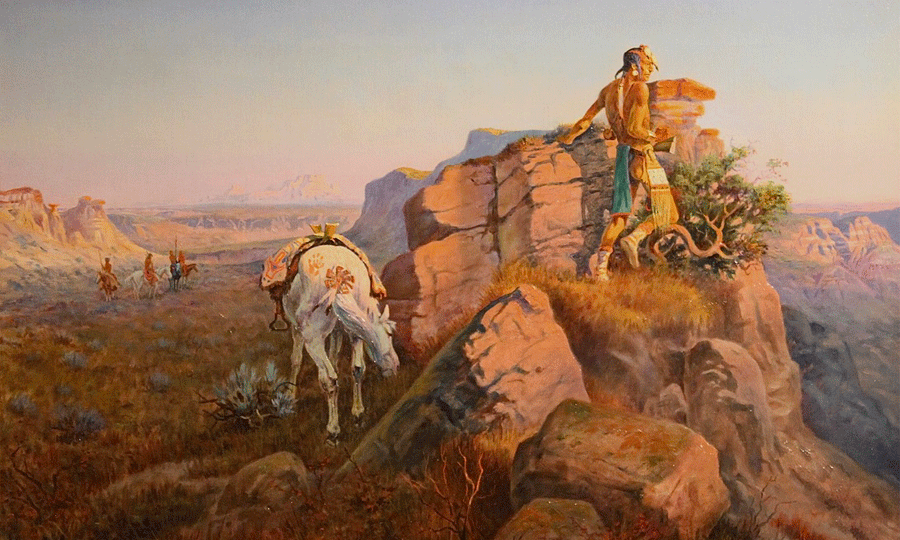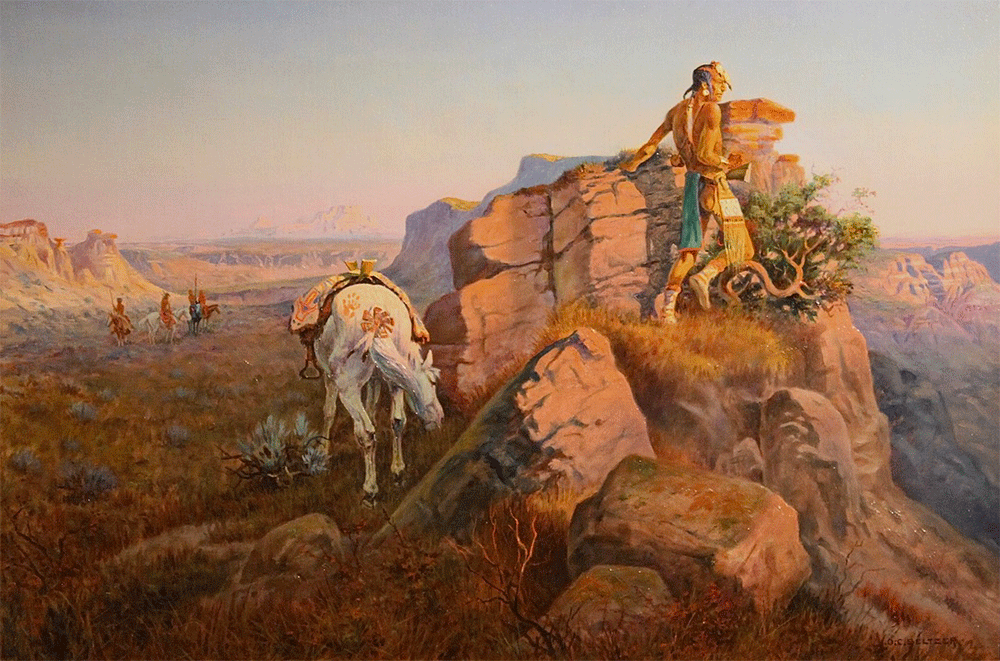O. C. Seltzer
If there ever was an artist who inspired a fellow artist, it was Charles M.
Russell who had a profound influence on Olaf Carl Seltzer (1877-1957). The cowboy artist helped bring out the best in his younger, Great Falls, Montana friend. While Russell was gregarious and enjoyed a crowd, Seltzer was quiet and somewhat withdrawn. They both saw the same truth, their love for Montana and the “West That Has Passed.”
Born on August 25, 1877 in Copenhagen, Denmark to German immigrant parents, Olaf was abandoned in infancy by his father. He found solace in drawing, which led to acceptance at the Tekniske Selskabe Institute, known to develop artisans. Yet the young artist dreamed of the American West of Buffalo Bill Cody. He and his mother Julie sailed to America on June 21, 1892 to join his sister Laura and her husband in Giant Springs, a short jaunt from Great Falls, Montana. His first job was a ranch hand for a local outfit, but soon he realized the wages were better working for the Great Northern Railway. In October 1893 he was employed as an apprentice machinist for the railway in Great Falls. A steady income allowed him to marry Mabel L. Cleland, and they eventually had two sons, Carl and Walter. Other jobs such as locomotive repairman found him riding trains throughout the northern Great Plains, sketching in his spare time.
His big break came from Russell patron Dr. Phillip Cole who by 1925 was one of the most important collectors of Western American art in the country. Cole was born in 1883 in Illinois but raised in Montana. Cole had met Seltzer on one of his trips to Montana, and for a year starting in 1926 Seltzer moved to New York to work on art commissions for him. Many more would follow. In 1928 he purchased a home on East Central Avenue and completed for Cole a series of watercolors that would be called the “Western Characters.”
In 1933 Cole had yet another project for Olaf. He was to paint the history of Montana in a series of oils, measuring no greater than six inches. He and Cole worked together on the commentary for each piece. The last of the oils was delivered to Cole in the autumn of 1935. The next year Cole photocopied the miniatures and assembled them into an impressive suede-covered volume he titled Montana in Miniature. At least four copies were produced. But Cole wouldn’t enjoy his collection long. On June 29, 1941 he died of a stroke at age fifty-seven. Several years later, Oklahoma oilman Thomas Gilcrease purchased for $400,000 much of Cole’s collection that included 560 paintings, sixty-two bronzes, and historical material. Half of the paintings were executed by Seltzer. They eventually found a home in 1949 when the Thomas Gilcrease Institute of American History and Art opened in Tulsa, Oklahoma.
Seltzer died in a Great Falls convalescent home on December 16, 1957. He once said, “If there is anything of lasting value in my art, it will survive. If not, it will perish.” He would be happy to know that him and his art—2,500 oil and watercolor paintings—were not forgotten. In 1960 the Montana Historical Society had a major retrospective of Seltzer’s paintings. Six years later art dealer Dr. Van Kirke Nelson in Kalispell, Montana and Cato K. Butler from Helena published Montana in Miniature, after finding one of Cole’s copies by the same name. In June 1979 the Gilcrease Museum had the largest one-man exhibit of Seltzer’s to date. Many exhibitions followed, including one at the C.M. Russell Museum in 2019. Besides his art, Olaf would be proud of his grandson, Steve Seltzer, who lives in Great Falls and is a noted and prolific artist.
Russell who had a profound influence on Olaf Carl Seltzer (1877-1957). The cowboy artist helped bring out the best in his younger, Great Falls, Montana friend. While Russell was gregarious and enjoyed a crowd, Seltzer was quiet and somewhat withdrawn. They both saw the same truth, their love for Montana and the “West That Has Passed.”
Born on August 25, 1877 in Copenhagen, Denmark to German immigrant parents, Olaf was abandoned in infancy by his father. He found solace in drawing, which led to acceptance at the Tekniske Selskabe Institute, known to develop artisans. Yet the young artist dreamed of the American West of Buffalo Bill Cody. He and his mother Julie sailed to America on June 21, 1892 to join his sister Laura and her husband in Giant Springs, a short jaunt from Great Falls, Montana. His first job was a ranch hand for a local outfit, but soon he realized the wages were better working for the Great Northern Railway. In October 1893 he was employed as an apprentice machinist for the railway in Great Falls. A steady income allowed him to marry Mabel L. Cleland, and they eventually had two sons, Carl and Walter. Other jobs such as locomotive repairman found him riding trains throughout the northern Great Plains, sketching in his spare time.
His big break came from Russell patron Dr. Phillip Cole who by 1925 was one of the most important collectors of Western American art in the country. Cole was born in 1883 in Illinois but raised in Montana. Cole had met Seltzer on one of his trips to Montana, and for a year starting in 1926 Seltzer moved to New York to work on art commissions for him. Many more would follow. In 1928 he purchased a home on East Central Avenue and completed for Cole a series of watercolors that would be called the “Western Characters.”
In 1933 Cole had yet another project for Olaf. He was to paint the history of Montana in a series of oils, measuring no greater than six inches. He and Cole worked together on the commentary for each piece. The last of the oils was delivered to Cole in the autumn of 1935. The next year Cole photocopied the miniatures and assembled them into an impressive suede-covered volume he titled Montana in Miniature. At least four copies were produced. But Cole wouldn’t enjoy his collection long. On June 29, 1941 he died of a stroke at age fifty-seven. Several years later, Oklahoma oilman Thomas Gilcrease purchased for $400,000 much of Cole’s collection that included 560 paintings, sixty-two bronzes, and historical material. Half of the paintings were executed by Seltzer. They eventually found a home in 1949 when the Thomas Gilcrease Institute of American History and Art opened in Tulsa, Oklahoma.
Seltzer died in a Great Falls convalescent home on December 16, 1957. He once said, “If there is anything of lasting value in my art, it will survive. If not, it will perish.” He would be happy to know that him and his art—2,500 oil and watercolor paintings—were not forgotten. In 1960 the Montana Historical Society had a major retrospective of Seltzer’s paintings. Six years later art dealer Dr. Van Kirke Nelson in Kalispell, Montana and Cato K. Butler from Helena published Montana in Miniature, after finding one of Cole’s copies by the same name. In June 1979 the Gilcrease Museum had the largest one-man exhibit of Seltzer’s to date. Many exhibitions followed, including one at the C.M. Russell Museum in 2019. Besides his art, Olaf would be proud of his grandson, Steve Seltzer, who lives in Great Falls and is a noted and prolific artist.

LOOKING FOR A SPECIFIC PIECE?
We would be pleased to assist you in locating a western artist or Indian piece that you are particularly interested in. Contact us today to begin the search for your next piece.
CONTACT THE GALLERY








